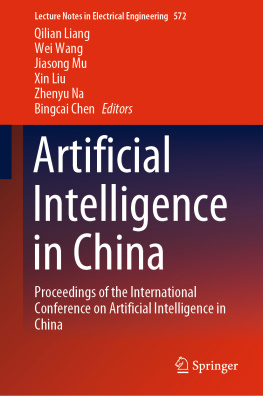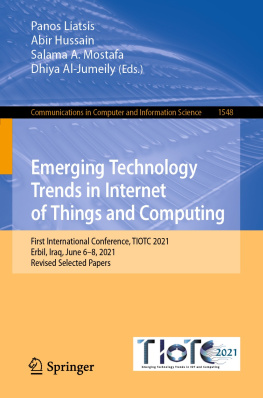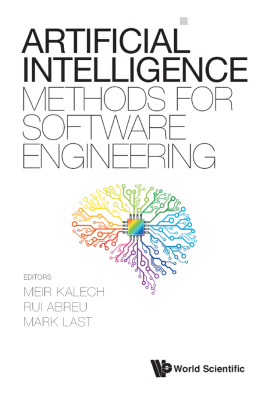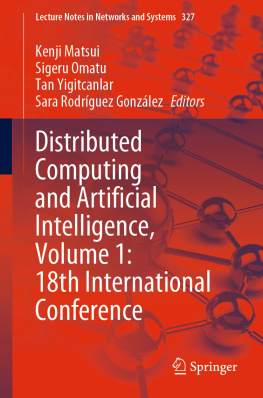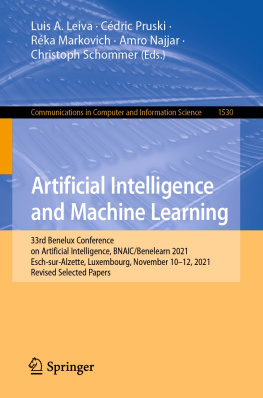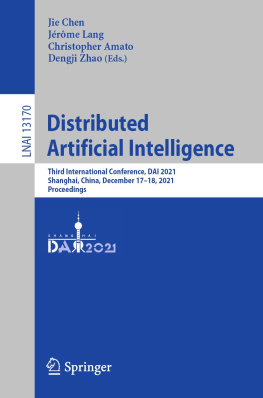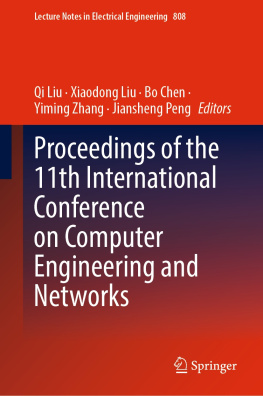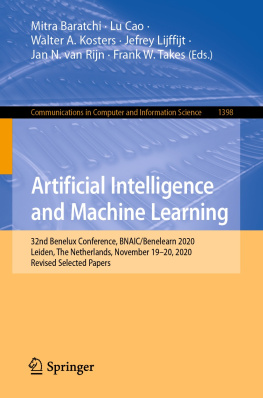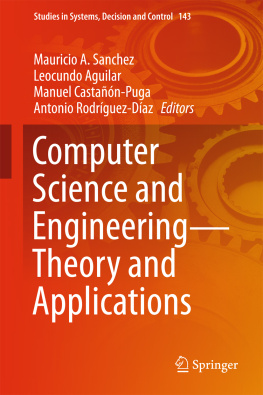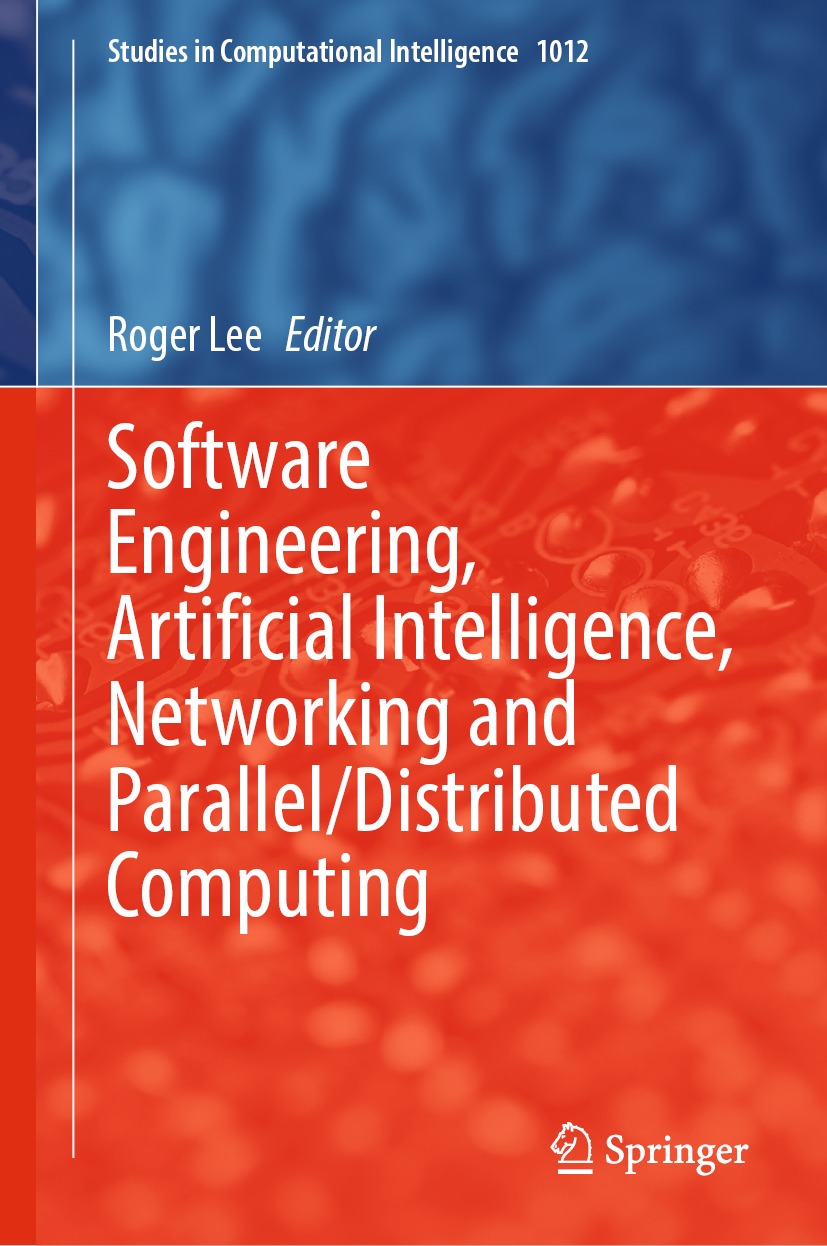Volume 1012
Studies in Computational Intelligence
Series Editor
Janusz Kacprzyk
Polish Academy of Sciences, Warsaw, Poland
The series Studies in Computational Intelligence (SCI) publishes new developments and advances in the various areas of computational intelligencequickly and with a high quality. The intent is to cover the theory, applications, and design methods of computational intelligence, as embedded in the fields of engineering, computer science, physics and life sciences, as well as the methodologies behind them. The series contains monographs, lecture notes and edited volumes in computational intelligence spanning the areas of neural networks, connectionist systems, genetic algorithms, evolutionary computation, artificial intelligence, cellular automata, self-organizing systems, soft computing, fuzzy systems, and hybrid intelligent systems. Of particular value to both the contributors and the readership are the short publication timeframe and the world-wide distribution, which enable both wide and rapid dissemination of research output.
Indexed by SCOPUS, DBLP, WTI Frankfurt eG, zbMATH, SCImago.
All books published in the series are submitted for consideration in Web of Science.
More information about this series at https://link.springer.com/bookseries/7092
Editor
Roger Lee
Software Engineering and Information Technology Institute, Central Michigan University, Mount Pleasant, MI, USA
ISSN 1860-949X e-ISSN 1860-9503
Studies in Computational Intelligence
ISBN 978-3-030-92316-7 e-ISBN 978-3-030-92317-4
https://doi.org/10.1007/978-3-030-92317-4
The Editor(s) (if applicable) and The Author(s), under exclusive license to Springer Nature Switzerland AG 2022
This work is subject to copyright. All rights are solely and exclusively licensed by the Publisher, whether the whole or part of the material is concerned, specifically the rights of translation, reprinting, reuse of illustrations, recitation, broadcasting, reproduction on microfilms or in any other physical way, and transmission or information storage and retrieval, electronic adaptation, computer software, or by similar or dissimilar methodology now known or hereafter developed.
The use of general descriptive names, registered names, trademarks, service marks, etc. in this publication does not imply, even in the absence of a specific statement, that such names are exempt from the relevant protective laws and regulations and therefore free for general use.
The publisher, the authors and the editors are safe to assume that the advice and information in this book are believed to be true and accurate at the date of publication. Neither the publisher nor the authors or the editors give a warranty, expressed or implied, with respect to the material contained herein or for any errors or omissions that may have been made. The publisher remains neutral with regard to jurisdictional claims in published maps and institutional affiliations.
This Springer imprint is published by the registered company Springer Nature Switzerland AG
The registered company address is: Gewerbestrasse 11, 6330 Cham, Switzerland
Preface
The purpose of the 22nd ACIS International Fall Virtual Conference on Software Engineering, Artificial Intelligence, Networking and Parallel/Distributed Computing (SNPD2021-Fall) held on November 2426, 2021, Taichung, Taiwan is aimed at bringing together researchers and scientists, businessmen and entrepreneurs, teachers and students to discuss the numerous fields of computer science and to share ideas and information in a meaningful way. This conference on Software Engineering, Artificial Intelligence, Networking and Parallel/Distributed Computing discussed the wide range of issues with significant implications, from artificial intelligence, to communication systems and networks, embedded systems, data mining and BigData, data-driven business models, data privacy and security issues.
This publication captures 13 of the conferences most promising papers, and we impatiently await the important contributions that we know these authors will bring to the field.
In Chapter 1, Yung-Kuan Chan, Chieh-Shan Lin, Hsuan-Jung Lin and Kei-Tung Yip propose an automatic new vertebral compression fracture detection system (ANVCFD system) to segment the spine regions from the MRI spine images and classify the extracted regions into five categories according to their symptoms.
In Chapter 2, Han Wang, Wencai Du and Shaobin Li deliver a review of key issues of DF top-level design and planning from the aspects of networking, precision, automation and digitalization. Solutions are explored based on 5G, TSN and DT advanced technologies, literately and practically.
In Chapter 3, Xin Yan, Mei Wang, Yuancheng Li and Minghang Li propose concentration-based robot control method with FPGA to simplify the operation of the control method, as a supplement to existing control methods.
In Chapter 4, Jeong Yang, Young Lee and Arlen P. McDonald investigate what caused a recent cybersecurity attack that took place on US governments and companies utilizing a popular network performance monitoring tool, SolarWinds. They propose solutions to prevent similar attacks in the future.
In Chapter 5, Chi-Shiang Chan, Li-Wei Chang and Yuan-Yu Tsai propose a data hiding technology by applying interpolation in Extended Local Binary Pattern (ELBP). The proposed method uses interpolation to predict pixels in blocks so as to reduce image distortion when compressing images using Extended Local Binary Pattern (ELBP).
In Chapter 6, Yung-Kuan Chan, Wei-Chin Lee, Wen-Xuan Chen, Yu-Chun Chen, Wu-Chun Tu and Zong-Han Yeh establish an insect species identification system, which can be divided into two main parts, object detection and insect species identification.
In Chapter 7, Sung-Hwa Han proposes a DIFA-based learning data-generating methodology for malware detection that can be applied to machine learning for malware detection by incorporating DIFA techniques into the execution process of the application process.
In Chapter 8, Myungkyum Kim, Jongwoo Park and Mikyung Cho present a study on the effect of educational service quality on career decision-making self-efficacy.
In Chapter 9, Wookjoon Sung and Changil Kim present a study on Nanotechnology Performance Analysis Using Topic Modeling and Social Network Analysis: Focusing on NTIS Data in Korea (20152019).
In Chapter 10, Taegu Kim, Su Yeon Kim and Min Jeong Shin present a study on Korea TV drama ratings. They try to analyze the factors that determine drama viewership ratings from two aspects, traditional programming strategy and a marketing strategy.
In Chapter 11, Jin-A Choi and Cyril S. Ku utilize text mining methods to identify and comparatively analyze shifting themes in the publics concerns regarding the coronavirus from February 2020 through June 2020.
In Chapter 12, Aiha Ikegami, Ryotaro Okada and Takafumi Nakanishi present a method for discovering of historical transition in aesthetic notions of waka poetry over by using changes in co-occurrence words. They focus on the three major anthologies of Japanese poetry, Manyoshu, Kokin Wakashu and Shin Kokin Wakashu, and on Kago, which is the central element in Japanese poetry.


